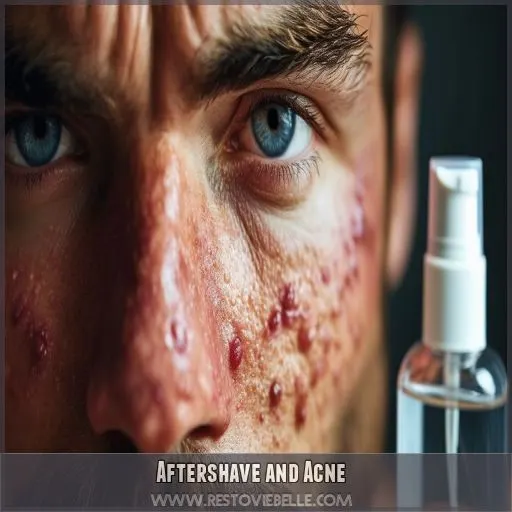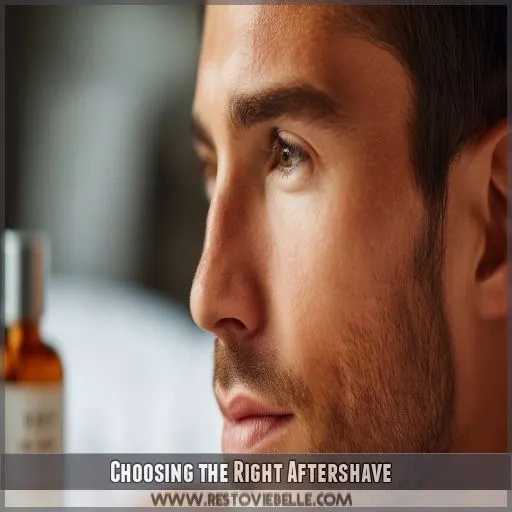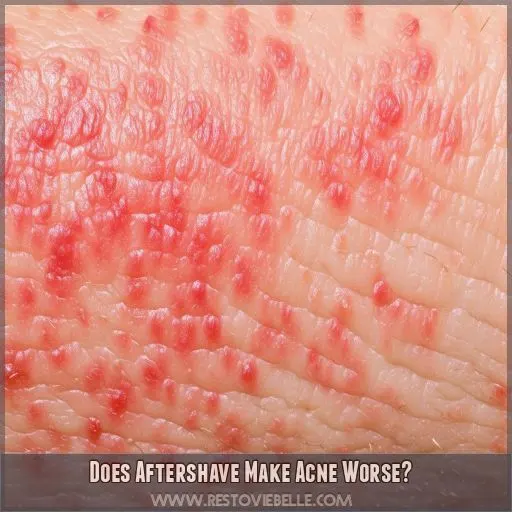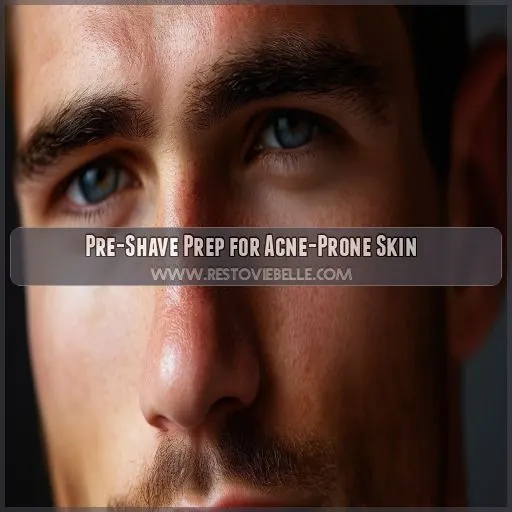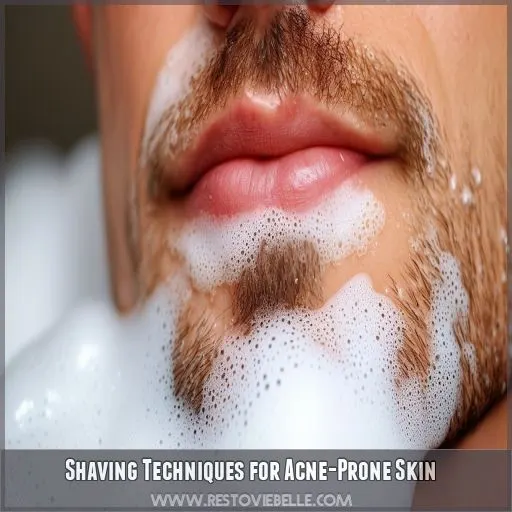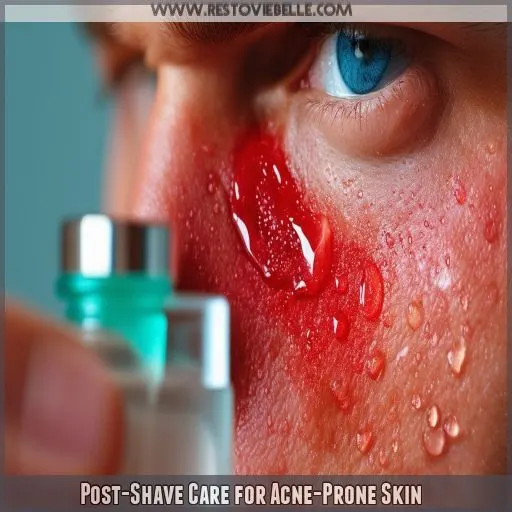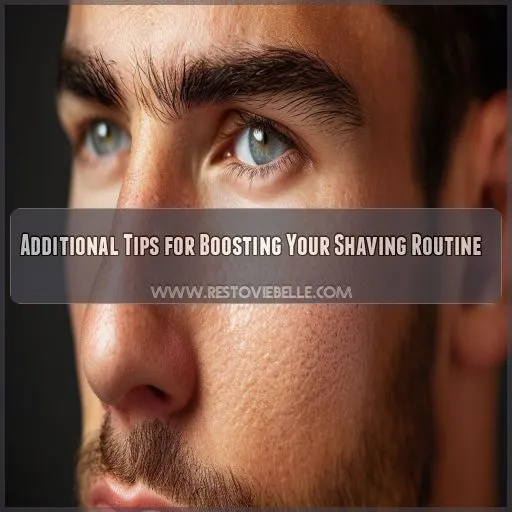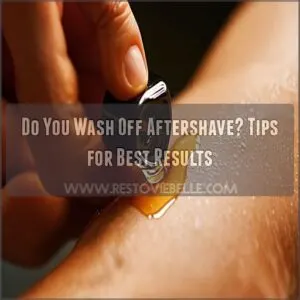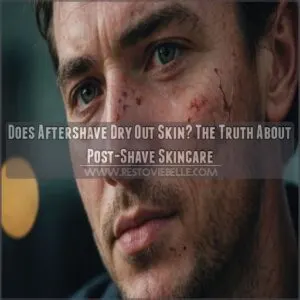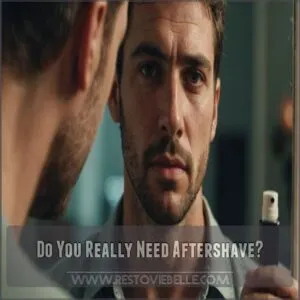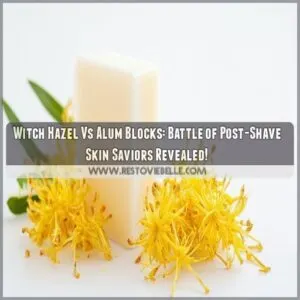This site is supported by our readers. We may earn a commission, at no cost to you, if you purchase through links.
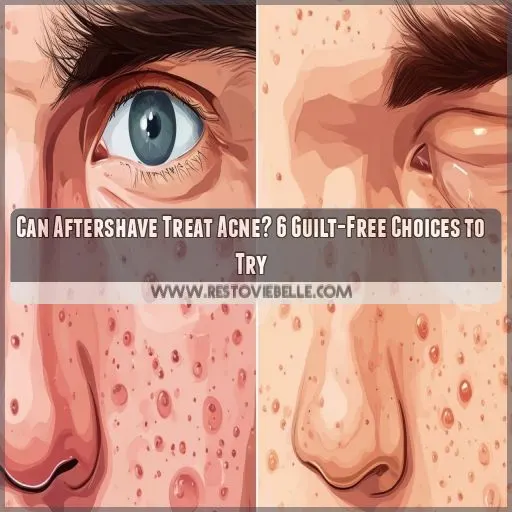
While some ingredients in aftershaves might help, it’s not a one-size-fits-all solution.
Some aftershaves contain acne-fighting ingredients like salicylic acid or benzoyl peroxide, which can help dry out excess oil and battle breakouts.
But here’s the catch – not all aftershaves are created equal. Some might even irritate your skin more, especially if they contain alcohol or fragrances.
So, while the right aftershave might lend a helping hand in the war against acne, it’s not a guaranteed win. It’s a case-by-case scenario, and what works for one person might not work for another.
The bottom line?
Aftershaves aren’t specifically designed to treat acne, but some might lend a helping hand. It’s a tricky path to navigate, and it’s always best to patch test and consult a dermatologist before trying something new on your skin.
Table Of Contents
- Aftershave and Acne: Friends or Foes?
- Choosing the Right Aftershave
- Does Aftershave Make Acne Worse?
- Pre-Shave Prep for Acne-Prone Skin
- Shaving Techniques for Acne-Prone Skin
- Post-Shave Care for Acne-Prone Skin
- Additional Tips for Boosting Your Shaving Routine
- Frequently Asked Questions (FAQs)
- Which Aftershave is best for acne prone skin?
- How do you effectively use overnight acne treatment?
- Is aftershave good for pimples?
- Can aftershave cause acne?
- Does aftershave help with acne?
- Is it OK to put aftershave on your face?
- Does shaving skin help with acne?
- Does aftershave improve skin?
- Can I prevent acne with aftershave?
- What ingredients should I avoid?
- How often should I change my razor?
- Is it okay to use acne medication before shaving?
- Whats the best way to dry my face after shaving?
- Conclusion
Key Takeaways
- Aftershaves aren’t a one-stop solution for acne, but some can help. The key is to choose the right ingredients and avoid irritants like alcohol and fragrances.
- Ingredients like salicylic acid, benzoyl peroxide, witch hazel, and tea tree oil can help dry excess oil and battle breakouts.
- Heavy oils like coconut or cocoa butter, dyes, and sulfates can clog pores and irritate acne-prone skin.
- Always patch test and consult a dermatologist before trying something new. It’s a delicate dance, but you might find an aftershave that becomes your trusted ally against breakouts.
Aftershave and Acne
Aftershave and Acne: Friends or Foes?
You might be wondering if your aftershave is secretly sabotaging your skin, especially if you’re prone to acne. It’s time to uncover the truth and set the record straight.
Understanding Acne and Aftershave
Acne is a skin condition that affects millions each year. It’s caused by a combo of excess oil, clogged hair follicles, bacteria, and inflammation. It can pop up on your face, chest, shoulders, or back.
When it comes to acne-prone skin, it’s a no-brainer to avoid oily ingredients. Greasy substances are like acne’s BFF, causing breakouts and irritation.
So, does that mean aftershave—a liquid often associated with a fresh shave and a tingly feel—can help or hurt acne?
Let’s take a closer look and explore the relationship between aftershave and acne-prone skin.
How Aftershave Ingredients Affect Acne
The ingredients in aftershave can either help or irritate acne-prone skin. It’s important to know which ingredients are friends and which are foes in the battle against breakouts.
| Ingredient Type | Effect on Acne |
|---|---|
| Alcohol | Dries up excess oil and kills acne-causing bacteria. |
| Witch Hazel | Fights bacteria and reduces skin inflammation. |
| Menthol | Soothes the skin and provides a cooling sensation. |
| Essential Oils (Tea Tree, Lavender) | Reduce inflammation and have antibacterial properties. |
| Heavy Oils (Coconut, Cocoa Butter) | Clog pores and aggravate acne. |
| Dyes and Sulfates | Can irritate sensitive, acne-prone skin. |
Benefits of Using Aftershave for Acne
While aftershave isn’t a direct treatment for acne, it can have some perks for acne-prone skin. Here’s a rundown:
- Anti-inflammatory properties: Some aftershaves contain ingredients like witch hazel, aloe, or tea tree oil, which can help reduce skin inflammation and provide a soothing effect.
- Bacteria-fighting power: Ingredients like alcohol, witch hazel, and essential oils (such as tea tree, lavender, or rosemary) can act as natural disinfectants, killing acne-causing bacteria.
- Oil control: Alcohol-based aftershaves can help dry up excess oil, which is a contributing factor to acne.
- Pain relief: Menthol, a common aftershave ingredient, provides a cooling sensation and topical pain relief, which can be especially soothing if you have acne.
Choosing the Right Aftershave
Choosing the right aftershave for acne-prone skin can be a tricky business. You want something that will soothe your skin and not make your acne worse. In this section, we’ll give you the lowdown on the ingredients to look out for and those to avoid, as well as the different types of aftershave that could work for your skin.
Ingredients to Look for in Aftershave for Acne
When choosing an aftershave, look for these acne-fighting ingredients:
- Alcohol to tighten pores and kill bacteria.
- Witch hazel to reduce inflammation and fight bacteria.
- Menthol for a cooling, soothing effect.
- Essential oils like tea tree, lavender, and rosemary to calm inflammation and banish bacteria.
Ingredients to Avoid in Aftershave for Acne
Choosing the right aftershave isn’t just about finding ingredients that help with acne, but also about avoiding certain ingredients that can clog pores and irritate your skin. Here’s what you should steer clear of:
- Comedogenic ingredients: These are the pore-clogging culprits. Stay away from coconut and linseed oil, lanolin, and cocoa butter, as they fall into this category.
- Dyes and sulfates: While not directly linked to acne, these ingredients can aggravate sensitive or troubled skin, so it’s best to give them a miss.
- Heavy oils: Oils like sunflower, safflower, and jojoba can be beneficial for the skin, but they mightn’t play well with acne-prone skin. These oils tend to be heavier and can clog pores, leading to more breakouts.
- Alcohol: While alcohol can be great for disinfecting and tightening pores, it can also dry out your skin. If you have acne, look for aftershaves with gentler antiseptics like witch hazel or tea tree oil.
Types of Aftershave for Acne-Prone Skin
Choosing the right aftershave for acne-prone skin can be tricky, but you have options:
- Splash aftershaves: These are liquid and often contain acne-fighting ingredients like alcohol or witch hazel. They’re a great choice if you want something that’ll tighten your pores and kill bacteria.
- Lotion aftershaves: If your skin is feeling dry, go for a lotion. These provide extra moisture without clogging your pores.
- Balm aftershaves: Balms are less astringent than lotions and have a higher oil content. Be careful with these if your skin is super oily, but they can be a good option if you need something soothing.
Does Aftershave Make Acne Worse?
You’ve heard the rumors, now it’s time to set the record straight: does aftershave make acne worse, or is it an urban legend? It’s time to uncover the truth and separate fact from fiction.
How Aftershave Can Irritate Acne
While aftershave doesn’t always worsen acne, certain ingredients can irritate your skin and trigger breakouts. Here’s how:
- Clogged pores: Some aftershaves contain heavy, oil-based ingredients that can clog pores and create a breeding ground for acne.
- Irritant ingredients: Comedogenic ingredients like coconut oil, linseed oil, lanolin, and cocoa butter are known pore-cloggers. Dyes and sulfates can also aggravate sensitive skin.
- Oil-based products: These can be problematic if you have acne-prone skin. They may leave a greasy residue, trapping bacteria and causing further inflammation.
- Alcohol’s impact: Alcohol, a common ingredient in aftershaves, can dry out your skin. While this might seem beneficial for acne, it can also strip your skin of its natural oils, leading to increased oil production and, you guessed it, more acne.
How to Choose an Aftershave That Won’t Worsen Acne
When choosing an aftershave, you want to avoid anything that’ll clog your pores and irritate your skin.
Go for products with acne-fighting ingredients like alcohol, witch hazel, and tea tree oil. These ingredients help kill bacteria and reduce inflammation.
Be cautious with moisturizing ingredients like glycerin, dimethicone, and mineral oil. While they hydrate the skin, some can clog pores, so opt for non-comedogenic formulas.
Common Mistakes to Avoid When Using Aftershave for Acne
If you’re trying to use aftershave to fight acne, watch out for these common mistakes:
- Shaving against the grain: This can lead to ingrown hairs, razor bumps, and irritation. Stick to shaving with the direction of hair growth to keep your skin happy.
- Using pre-shave or post-shave oils: While these might seem like a good idea, they can actually clog your pores and make acne worse.
- Dull razor blades: A sharp blade is a happy blade. Don’t tug and irritate your skin with a dull razor.
- Pressing too hard: Take it easy, tiger! Applying too much pressure can cause razor burn and ingrown hairs.
- Over-shaving: Your skin needs time to heal. Give it a break between shaves.
Pre-Shave Prep for Acne-Prone Skin
If you’re dealing with acne-prone skin, prepping your skin before shaving is really important. A few simple steps can make a big difference in preventing acne breakouts and achieving a smooth, irritation-free shave.
Let’s take a closer look at the pre-shave rituals that will set the stage for a seamless shaving experience and keep those pesky pimples at bay.
Warm Water Wash for a Smooth Shave
Before you pick up that razor, it’s time for some pre-shave prep to get your skin ready for a close shave. Here’s a simple routine to make sure your skin is prepped and ready:
- Splash your face with warm water: This simple step helps to soften your beard and open up your pores, making it easier for your razor to glide through those stubborn hairs. Think of it like a warm-up session for your skin and beard!
- Create a rich lather: Whether you’re using a shaving gel, cream, or soap, take your time to work up a nice, creamy lather. This will provide a slippery surface for your razor to move smoothly, reducing the chances of irritation and nicks.
- Apply a hot towel (optional): For an extra indulgent experience, try this barbershop trick. Soak a clean towel in hot water, wring it out, and apply it to your face for a few minutes. This step helps to further open your pores and deeply hydrate your skin, resulting in a more comfortable shave.
- Massage your skin: As you apply the lather, use gentle circular motions to massage your skin. This helps to stimulate blood flow and lift the hairs, making them easier to cut. It’s like giving your face a mini spa treatment!
- Rinse and repeat: If you have a thick beard or sensitive skin, consider rinsing with warm water and reapplying the lather during your shave. This keeps your skin hydrated and makes sure the lather doesn’t dry out, reducing irritation.
Gentle Cleansers for Acne-Fighting
Before you even pick up that razor, it’s important to prep your skin with a gentle cleanser. But why, you ask? Well, think of it like laying the foundation for a house—you need a clean, smooth canvas to build upon.
Here’s the deal: a good cleanser will wash away dirt, oil, and bacteria, creating a pristine path for your razor to glide through. But not just any cleanser will do. Steer clear of harsh bar soaps that’ll strip your skin of its natural oils and leave it feeling drier than the Sahara.
Instead, opt for a liquid cleanser with acne-fighting ingredients like salicylic acid. This powerhouse ingredient unclogs pores and slays those pesky breakouts. It’s like having a personal acne assassin on your vanity.
Check out this table for a quick comparison of some gentle cleansers that pack a punch against acne:
| Product | Key Ingredients | Benefits |
|---|---|---|
| Cleanser A | Salicylic Acid, Glycolic Acid | Fights acne, exfoliates |
| Cleanser B | Benzoyl Peroxide, Tea Tree Oil | Acne treatment, soothes skin |
With the right cleanser, you’re setting the stage for a smooth shave and giving acne the boot. So, go ahead and lather up—your skin will thank you!
Gentle Exfoliation for Preventing Ingrown Hairs
Exfoliation is key to preventing ingrown hairs and keeping your skin happy. Here’s the lowdown:
- Scrub gently: Use a gentle scrub to remove dead skin cells and unclog pores. Think of it like sweeping away dust bunnies – you’re creating a clean slate for shaving.
- Avoid irritation: Be kind to your skin and avoid harsh exfoliants that can cause micro-tears. No one wants an angry, red face.
- Keep it regular: Make exfoliation a regular part of your pre-shave routine. Consistency is key to keeping those pesky ingrown hairs at bay.
Shaving Techniques for Acne-Prone Skin
Now that you’ve prepped your skin, it’s time to master the art of shaving with acne-prone skin. In this section, we’ll talk about shaving techniques that will help you get a close shave while minimizing irritation and keeping those pesky pimples at bay.
Shaving With the Grain for Minimizing Irritation
Shaving with the grain is a simple technique that can make a big difference in reducing skin irritation. This means shaving in the same direction as your hair grows. It might feel counterintuitive, especially if you’re used to a super-close shave, but it’s a game-changer for acne-prone skin. By following the natural direction of hair growth, you minimize the chances of hair tugging, irritation, and those dreaded ingrown hairs.
| Technique | Benefits | Tips |
|---|---|---|
| Shave with the grain | Minimizes irritation | Use a gentle, moisturizing shaving cream |
| Reduces razor bumps | Take your time and go slow | |
| Prevents ingrown hairs | Rinse your razor frequently | |
| Avoid pressing too hard |
Using a Sharp Razor for a Close Shave
Using a sharp razor is key to a smooth shave routine and can help prevent skin irritation. A dull blade can tug at hairs, causing razor burn and ingrown hairs. Here are some quick tips to keep in mind:
- Change your razor blade regularly, around every 10 shaves, to maintain sharpness and prevent bacteria buildup.
- Rinse the blade frequently during shaving to remove hair and shaving cream, reducing clogging and bacteria growth.
- Avoid pressing too hard on the skin.
- Opt for a gentle, moisturising shaving cream to help the razor glide smoothly.
Rinsing Frequently to Prevent Clogging and Bacteria Buildup
Rinsing your razor frequently during shaving is a simple yet effective way to prevent clogging and bacteria buildup, especially if you’re prone to acne.
This is because hair and shaving cream can accumulate on the razor, creating a breeding ground for bacteria.
Post-Shave Care for Acne-Prone Skin
So, you’ve mastered the art of shaving with acne-prone skin, but now it’s time to focus on post-shave care. This is an essential step to soothe irritation and prevent those annoying pimples from popping up. We’re here to guide you through the do’s and don’ts of post-shave skin care, so you can keep your skin happy and healthy.
Cooling Down With a Cool Water Rinse
After shaving, it’s time to cool things down—literally. A cool water rinse is a simple yet effective way to soothe your skin and reduce inflammation. Here’s why it works:
- Pore Tightening: A cool water rinse helps to close up your pores, reducing the chances of dirt and bacteria getting in and causing acne breakouts.
- Inflammation Reduction: The cool temperature constricts blood vessels, reducing redness and calming irritated skin.
- Cooling Sensation: It provides an instant cooling feel, like a nice cool breeze for your skin.
- Use slightly chilled water, not icy cold. You don’t want to shock your skin, just give it a gentle cooling sensation.
- Splash your face with the cool water a few times, gently patting it dry with a soft, clean towel.
- Finish with a light, non-comedogenic moisturiser to lock in hydration and protect your skin.
Pat Drying Gently to Prevent Irritation
Once you’ve rinsed with cool water, it’s time to dry off. But forget about rubbing your face vigorously with a towel. Instead, opt for a gentle pat-dry technique. This simple method can help prevent irritation and redness, especially if you have sensitive skin. Imagine your skin saying, "Ah, that feels good!" after a soothing pat-down.
Moisturizing With Non-Comedogenic Formula
Choosing the right moisturizer is key for acne-prone skin. Opt for a moisturizer with non-comedogenic ingredients like niacinamide or hyaluronic acid. These ingredients hydrate your skin without clogging pores. Avoid moisturizers with heavy, greasy formulas that can worsen acne.
Additional Tips for Boosting Your Shaving Routine
Besides choosing the right aftershave, there are a few extra tips to elevate your shaving routine and keep acne at bay. From blade upkeep to seeking expert advice, these strategies help you get a smoother, clearer complexion.
Replacing Razor Blades for a Smooth Shave
A sharp blade is key to a smooth shave. Dull blades can tug at hairs, causing razor burn and ingrown hairs. Aim to replace your razor blade every 10 shaves to keep it sharp and prevent bacteria buildup. This small investment will pay dividends in the form of a comfortable, irritation-free shave.
Considering Medicated Anti-Acne Treatment
If you’re dealing with persistent acne, it might be time to bring out the big guns: medicated treatments. Here are some options to explore:
- Topical treatments
- Oral medications
- Combination therapy
Consulting a Dermatologist for Personalized Advice
If you’re dealing with persistent acne or skin concerns, consulting a dermatologist is a smart move.
They’re skin specialists who can provide personalized advice and treatment plans.
Everyone’s skin is unique, so getting customized recommendations can be a game-changer.
Don’t worry; it’s not as scary as it sounds.
Dermatologists are there to help you tackle your skin woes and boost your confidence.
They’ll work with you to find the right shaving routine and products that suit your skin’s needs.
So, if you’re struggling, consider booking an appointment.
It might be the first step to clearer, happier skin.
Frequently Asked Questions (FAQs)
Which Aftershave is best for acne prone skin?
If you’re prone to acne, opt for a splash or lotion aftershave. Splash aftershaves contain alcohol or witch hazel, which tighten pores and kill bacteria. Lotion aftershaves are ideal for dry skin, providing necessary hydration without clogging pores.
How do you effectively use overnight acne treatment?
Overnight acne treatments can help zap those zits. Try spot treatments with benzoyl peroxide, salicylic acid, or natural remedies like neem oil, honey and cinnamon, or green tea. Apply before bed and let them work their magic while you sleep.
Is aftershave good for pimples?
Some aftershave ingredients can help fight acne, like alcohol, witch hazel, and tea tree oil, which kill bacteria and reduce inflammation. But heavy, oil-based aftershaves can clog pores and irritate pimples.
Can aftershave cause acne?
Nope, it’s not the aftershave itself that causes acne. But, some ingredients in aftershaves can clog pores and irritate skin, leading to acne. So, choose aftershaves with care and avoid pore-clogging additives.
Does aftershave help with acne?
While aftershave doesn’t directly treat acne, certain ingredients can help. Alcohol, witch hazel, and tea tree oil can reduce inflammation and kill acne-causing bacteria. Essential oils like lavender and rosemary can also help.
Is it OK to put aftershave on your face?
Yes, it’s generally fine to apply aftershave to your face, but it’s important to choose the right type of aftershave and avoid certain ingredients that can aggravate acne.
Does shaving skin help with acne?
Shaving can worsen acne as hair follicles are cut, leaving a wound that may become infected. However, some say dermaplaning, a form of exfoliation, can help prevent acne by unclogging pores.
Does aftershave improve skin?
Some aftershave ingredients can help improve acne-prone skin by reducing inflammation and killing bacteria. However, other ingredients can irritate and clog pores, so it’s important to choose the right products.
Can I prevent acne with aftershave?
Can you prevent acne with aftershave?" you ask. Well, it’s a bit of a tricky situation. While some ingredients in aftershaves can help fight acne, others might just make it worse. So, it’s a bit of a balancing act, really.
What ingredients should I avoid?
You should avoid aftershaves with pore-clogging ingredients like coconut oil, sweet almond oil, peanut oil, olive oil, sunflower oil, safflower oil, and jojoba oil. Alcohol-based aftershaves can also dry out skin, increasing acne risk.
How often should I change my razor?
To keep your shaving routine on point, swap out your razor blade every 10 shaves. This keeps bacteria at bay and helps you get a close, comfy shave.
Is it okay to use acne medication before shaving?
Yes, it’s fine to use acne medication before shaving. Just make sure you follow the instructions on the medication and give it time to work before you start shaving.
Whats the best way to dry my face after shaving?
A stitch in time saves nine," they say, and it rings true for your shaving routine. After shaving, the best way to dry your face is to pat it gently with a clean towel. Avoid rubbing, as this can irritate your skin.
Conclusion
So, can aftershave help treat acne?
Well, it’s a bit of a mixed bag.
While some aftershaves contain acne-fighting ingredients that can lend a helping hand, it’s not a one-size-fits-all solution.
The key is to choose the right aftershave with the right ingredients and avoid potential irritants like alcohol and fragrances.
It’s a delicate dance, but with the right moves, you might just find an aftershave that becomes your trusted ally in the battle against breakouts.

